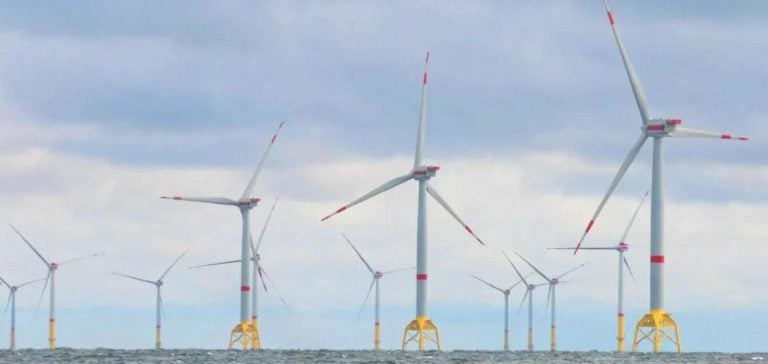Iberdrola commissions the Saint-Brieuc offshore wind farm, as part of France’s strategy to diversify its energy sources.
With a capacity of 496 megawatts (MW), this wind farm represents a significant step forward in the national effort to increase the production of electricity from renewable sources.
Located off the coast of Brittany, it supplies electricity to almost a million people, underlining the crucial role of offshore wind power in the country’s energy supply.
Construction of the wind farm began in 2012, with a total investment of 2.4 billion euros.
Comprising 62 8 MW wind turbines, the project marks a significant technological advance, with the turbines installed being among the most powerful in France.
The project meets the growing demand for emission-free energy production, contributing to the decarbonization objective set by the French government.
Technical challenges and innovations
The development of the Saint-Brieuc wind farm has required significant innovation, particularly for the installation of offshore wind turbines.
One of the main challenges was the complex marine conditions, in particular the rocky nature of the seabed composed of basalt.
Teams on site had to devise specific anchoring techniques to ensure the stability of the structures.
This project represents a breakthrough in offshore wind technology, and reflects the ability of European industry to overcome the technical challenges of the marine environment.
The turbines, supplied by Siemens-Gamesa, are mounted on foundations produced by the Navantia-Windar consortium, and partially assembled in the port of Brest.
These collaborations with European companies illustrate the integration of the offshore wind industry’s industrial supply chain.
Strong European involvement
The Saint-Brieuc project involves some 150 European companies, reflecting a large-scale collaborative approach in the wind power sector.
This cooperation not only supports local employment, with over 500 jobs created in Brittany, but also strengthens France’s position in renewable energy production.
Among the companies involved, Siemens-Gamesa is in charge of turbine production, while Prysmian is involved in laying the submarine cables.
Van Oord, a specialist in offshore work, will install the equipment.
The contribution of European industry to this project demonstrates the determination of players in the sector to ensure an energy transition based on offshore wind power, a sector that is still relatively young in France compared with other European countries such as the UK and Germany.
Outlook for offshore wind power in France
The Saint-Brieuc wind farm is the second offshore wind farm to be commissioned in France, a country where offshore wind power still represents a modest share of the energy mix.
However, the inauguration of this project illustrates the determination of the French authorities to strengthen this strategic sector, in line with the commitments made under the French Energy Transition Act.
Other projects are currently under development, with a particular focus on making the most of France’s maritime resources.
The location of future offshore wind farms, particularly in the English Channel and the Atlantic, testifies to the diversity of opportunities offered by the French coastline for wind power.
Iberdrola’s role in offshore wind energy
Beyond Saint-Brieuc, Iberdrola continues to expand its offshore wind activities in Europe and beyond.
The company operates several wind farms in the UK and Germany, and has recently launched projects in the USA.
Iberdrola’s portfolio of projects under development in offshore wind power is testimony to its expansion strategy in this key area for Europe’s energy transition.
Iberdrola is thus positioning itself as a major player in the global expansion of renewable energies, banking on the potential of offshore wind power to meet the growing energy needs of industrialized countries.
With more than 15 billion euros invested in wind farms currently under construction, offshore wind power is a key part of Iberdrola’s growth strategy.
The Group also has seabed exploitation rights for future projects, notably in Australia, the United States and Japan.
An industrial challenge for France
Offshore wind power represents not only an energy challenge, but also a major industrial challenge for France.
The involvement of over 150 companies in the construction of Saint-Brieuc demonstrates the country’s ability to mobilize its resources to become a European leader in renewable energies.
Collaborations with European companies also show that the energy transition relies on strong international cooperation, which is essential to the success of such projects.
The commissioning of Saint-Brieuc paves the way for a proliferation of similar projects, which will benefit both French industry and the country’s energy security.
The potential of offshore wind power in France is still largely under-exploited, but the projects currently underway should boost this energy’s share of the French energy mix in the years to come.






















